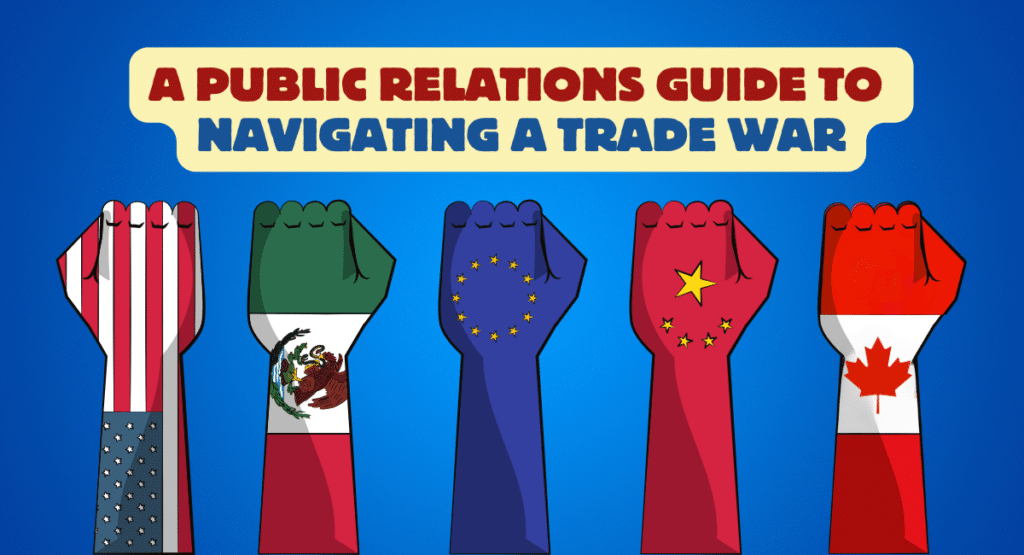A Public Relations Guide to Navigating a Trade War, From an Expert Who’s Been In the Trenches

Trade wars and tariffs aren’t easy on anyone—especially investors, if the markets mean anything—but they can be especially challenging for PR professionals at major brands.
Rapidly changing and downright unpredictable global trade dynamics and geopolitical uncertainties are bad for business. They’re also notoriously difficult for communicators to navigate. So what are some of the risks involved, and how can PR teams get their organizations through them relatively unscathed?
Fullintel spoke with a veteran PR practitioner with years of experience navigating these issues to determine just that.
The PR Challenges and Risks of a Trade War
Bradley Akubuiro, a Partner at Washington D.C.-based Bully Pulpit International, says that even though tariffs haven’t yet come into full effect (at the time of this writing), the risks for companies “aren’t theoretical. They’re hitting balance sheets in real time.”
No business likes an unpredictable and unstable environment, after all. Such an environment makes operational planning much harder, which can make corporate messaging an extremely high stakes and fraught game.
“For communicators, the challenge is navigating a fragmented geopolitical landscape while maintaining a unified sense of organizational identity,” explains Akubuiro, who was a top spokesperson for Boeing and United Technologies Corp. (now Raytheon Technologies Corp.) during the first Trump administration in the U.S.
Akubuiro’s firm also includes former White House and Senate comms leaders, including a former Assistant U.S. Trade Representative.
“What reassures stakeholders in one market might trigger backlash in another. Add in the current media environment—where narratives often take off before facts can catch up—and the risks of silence, missteps, or misalignment grow exponentially,” he continues. “The job now is not just to react quickly, it’s to anticipate wisely and speak with precision under pressure.”
What Steps Should PR Teams Take in a Trade War?
Given the increasingly high stakes for organizations and a business environment that some practitioners may have never experienced, it can be difficult to know what to do to maintain stakeholder trust and confidence.
Akubuiro says there are several steps PR teams and their organizations should take:
- Stay consistent: To maintain consumer and stakeholder trust, organizations must set and abide by one consistent set of standards. While this doesn’t mean sticking with just one message, communications should be rooted in clear values. Teams should pressure-test messaging internally and tailor messages to reflect the realities and expectations of each audience.
Maybe most importantly, he says, organizations should resist the urge to sanitize their comms “to the point of uselessness. Stakeholders want clarity, not calculated ambiguity.” - Address realities, not ambiguities. As mentioned above, it’s important to stay away from meaningless or ambiguous statements that may feel safe but can lead to stakeholder frustration and even public anger or ridicule.
Such statements “create a vacuum that others will fill, often with speculation or outrage. Companies should instead be upfront about challenges, direct about trade-offs, and clear about how they’re adapting.”
Organizations should explain how any changes or pivots are part of a well-executed, long-term strategy. Needless to say, coming off as panicky or reactive can be devastating.
“Uncertainty is not the enemy of confidence—confusion is,” explains Akubuiro. “If stakeholders understand the ‘why’ behind your choices, they’re far more likely to stay with you through the turbulence.” - Stay ahead of the story. PR teams at organizations need to do everything possible to monitor geopolitical developments, trade policies, and legislative shifts with the same rigor as financial performance, Akubuiro says. “What feels like a background issue today could be front-page news tomorrow.”
- Have a seat at the boardroom table. It’s crucial for PR teams to have a seat at the big table to not only manage what’s being said, but to anticipate how those messages will be heard by a broader audience.
Organizations that make significant business decisions without PR insight or feedback risk making operational choices that “undermine their own credibility or ignite controversy that they’re not prepared to handle.”
Additional advice from Akubuiro includes building adaptable messaging frameworks based on various scenarios and risk levels, operational realities, and stakeholder priorities. He also recommends PR teams align with other functions such as legal, HR, policy, and operations to ensure tight and unified messaging.
“Avoiding the hard conversations isn’t an option anymore,” he says. “In moments of uncertainty, people pay close attention to how your company is showing up. That means comms teams need to deeply understand cultural and political nuances.”
Above all, however, he says it’s fundamental for organizations to appear resilient in the face of swirling change. “Stakeholders need to see that your company doesn’t crumble in chaos—it adapts, learns, and leads,” he says.
“That’s what inspires confidence, especially when we’re all facing a future that is unclear.”
Companies across the world—from governmental and educational institutions, to Fortune 500 companies—use Fullintel to keep their finger on the pulse of the news that matters to them, from trade war-related coverage to competitive analysis. To learn more about what Fullintel can do for your business in unpredictable times, contact us today.

Jim Donnelly is a former journalist and content marketing and communications consultant who works with clients across a range of industries, including mobile technology, IT security, enterprise IT consulting, and media monitoring and intelligence. His previous roles have included Chief Media Officer at Canada’s largest IT and technology association, a director at a major media intelligence firm and, prior to that, editor-in-chief at a regional business publication.



